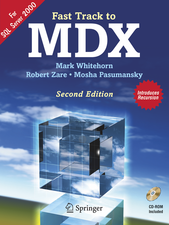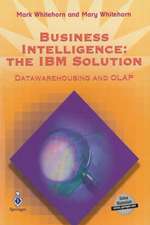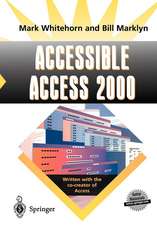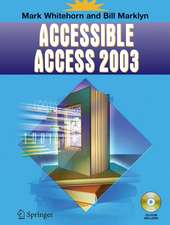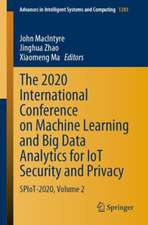Inside Relational Databases with Examples in Access
Autor Mark Whitehorn, Bill Marklynen Limba Engleză Paperback – 31 oct 2006
Preț: 228.52 lei
Preț vechi: 285.65 lei
-20% Nou
Puncte Express: 343
Preț estimativ în valută:
43.74€ • 45.49$ • 36.65£
43.74€ • 45.49$ • 36.65£
Carte disponibilă
Livrare economică 20 februarie-06 martie
Preluare comenzi: 021 569.72.76
Specificații
ISBN-13: 9781846283949
ISBN-10: 1846283949
Pagini: 372
Ilustrații: XIV, 372 p.
Dimensiuni: 210 x 279 x 23 mm
Greutate: 0.75 kg
Ediția:2007
Editura: SPRINGER LONDON
Colecția Springer
Locul publicării:London, United Kingdom
ISBN-10: 1846283949
Pagini: 372
Ilustrații: XIV, 372 p.
Dimensiuni: 210 x 279 x 23 mm
Greutate: 0.75 kg
Ediția:2007
Editura: SPRINGER LONDON
Colecția Springer
Locul publicării:London, United Kingdom
Public țintă
Professional/practitionerCuprins
A simple, single-table database.- to Part 1.- Tables.- Queries/Views.- Forms.- Reports.- Summary of Part 1.- A multi-table database.- to Part 2.- Serious problems with single tables.- Multiple tables cure serious problems.- Making multiple tables work together.- Getting the data into the correct tables.- Relationships in the real world.- How are relationships modeled?.- Revisiting the big four — the synergy begins.- Integrity.- Summary of Part 2.- Database Design & Architecture.- Database design.- The seven layers of wisdom.- Database architecture.- Related database topics.- What exactly is a relational database?.- 22 Triggers and stored procedures.- Transactions, logs, backup, locking and concurrency.- Codd’s rules.- Normalization.- More about normalization.- The system tables.- More on queries: data manipulation.- SQL.- Domains.- What does null mean?.- Primary keys.- Speeding up your database.- Hardware considerations.- Indexing.- More on optimization.- Denormalization.
Notă biografică
Mark Whitehorn teaches database design and practice, both to undergraduates and in the commercial world.
Textul de pe ultima copertă
Inside Relational Databases was first published in 1997 and, rather to our surprise, rapidly reached the status of a classic work in the database field. Translated into three other languages and sold all over the world, it has helped thousands of people to understand the relational model that underpins all modern databases.
Inside Relational Databases has never been about how to use a particular database engine (Access, SQL Server, MySQL, whatever). Instead, it’s about the underlying way in which relational databases work. However it is very convenient if the book illustrates the relational model using the reader’s favorite product – such as Access. So, for the new edition we produced several different versions of the same book, each version based on a different database engine. The version in your hand is based around Access (hence the title). There are other versions based around SQL Server and MySQL.
You shouldn’t buy this book if you are looking for a bookabout how to use Access. You should buy this book if you have created databases but they don’t seem to work very well. Perhaps you:
•can’t retrieve the information that you want.
•have to type in the same information over and over again.
•type in data and it appears to go missing.
•ask questions and get answers that you know are wrong.
•can use Access but you don’t know exactly what to do with it.
•know that a relational database lets you create multiple tables in the database but you are uncertain why this is to your advantage.
Or perhaps you hear words in connection with databases like:
•normalization
•functional dependency
•inner join
•union
•redundant data
•data dictionary
•meta-data
•ER modeling
•transaction
•concurrency
•locking
You haven’t got the faintest idea what they mean andthere is no one you can ask.
We have also taken the opportunity of the new edition to restructure the book significantly. I (Mark) continue to teach database design and practice, both to undergraduates and in the commercial world. Without doubt the most popular topic in the commercial world is how to make databases run faster (no great surprise there) so we have added an entire section of brand new material (more than 10% of the entire book) on that topic. The section on designing databases has been reorganized and expanded and we also re-read the entire book (several times) and brought it all up to date.
Inside Relational Databases has never been about how to use a particular database engine (Access, SQL Server, MySQL, whatever). Instead, it’s about the underlying way in which relational databases work. However it is very convenient if the book illustrates the relational model using the reader’s favorite product – such as Access. So, for the new edition we produced several different versions of the same book, each version based on a different database engine. The version in your hand is based around Access (hence the title). There are other versions based around SQL Server and MySQL.
You shouldn’t buy this book if you are looking for a bookabout how to use Access. You should buy this book if you have created databases but they don’t seem to work very well. Perhaps you:
•can’t retrieve the information that you want.
•have to type in the same information over and over again.
•type in data and it appears to go missing.
•ask questions and get answers that you know are wrong.
•can use Access but you don’t know exactly what to do with it.
•know that a relational database lets you create multiple tables in the database but you are uncertain why this is to your advantage.
Or perhaps you hear words in connection with databases like:
•normalization
•functional dependency
•inner join
•union
•redundant data
•data dictionary
•meta-data
•ER modeling
•transaction
•concurrency
•locking
You haven’t got the faintest idea what they mean andthere is no one you can ask.
We have also taken the opportunity of the new edition to restructure the book significantly. I (Mark) continue to teach database design and practice, both to undergraduates and in the commercial world. Without doubt the most popular topic in the commercial world is how to make databases run faster (no great surprise there) so we have added an entire section of brand new material (more than 10% of the entire book) on that topic. The section on designing databases has been reorganized and expanded and we also re-read the entire book (several times) and brought it all up to date.
Caracteristici
A reader-friendly explanation of the relational model and it's importance to database designers and developers, tailored to suit Access users













